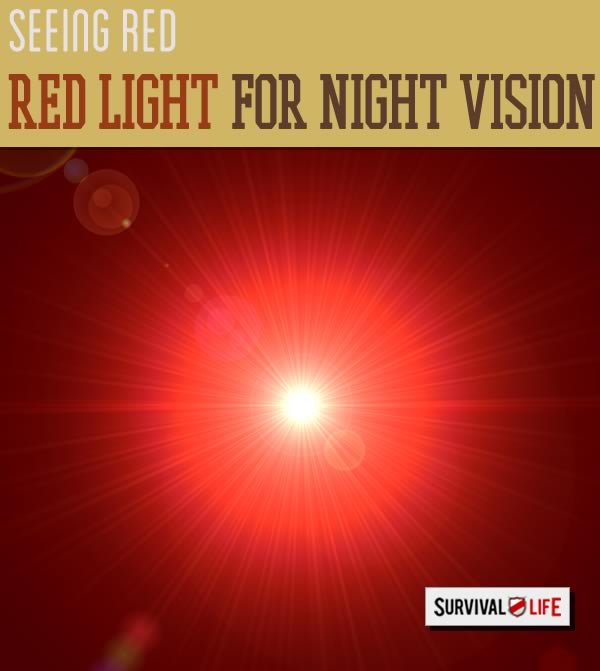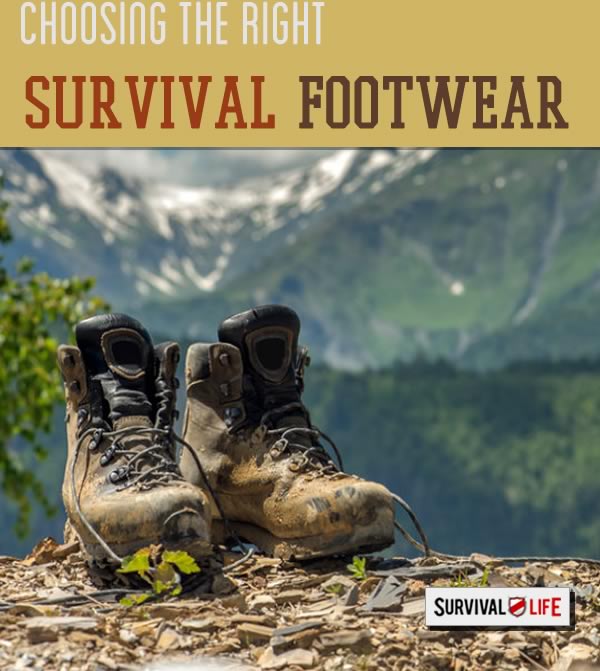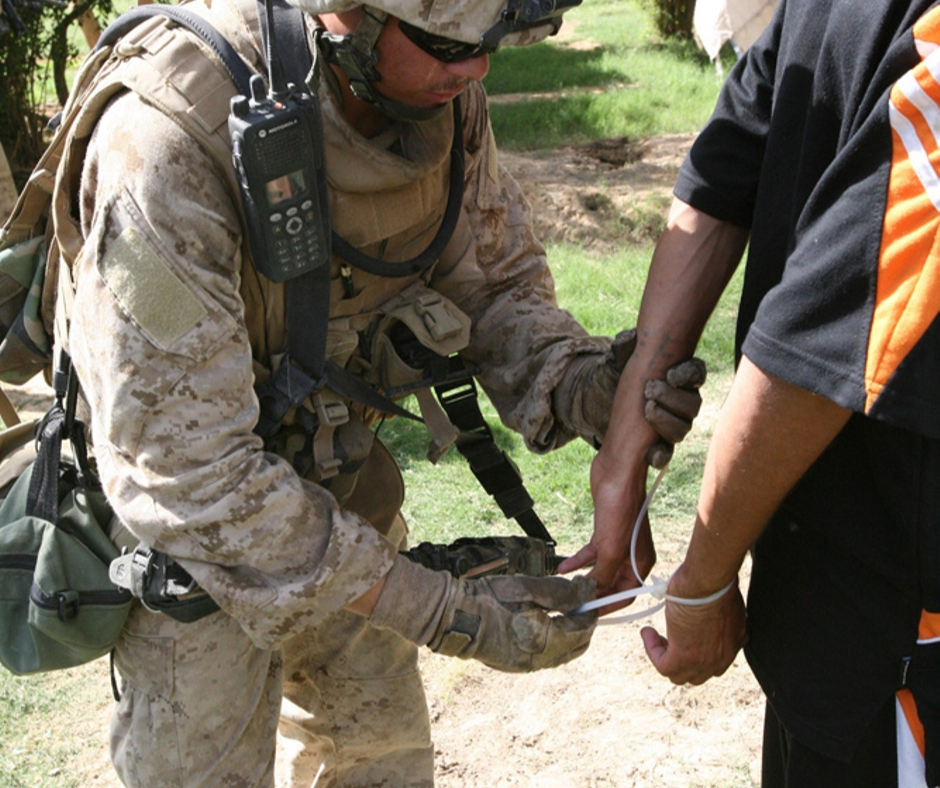Featured Articles
Night Vision: The Case for Red at Night

Why is Red Light Used for Night Vision?
Due to the way our eyes work, we require at least half an hour of exposure to a dimmed environment in order to completely adapt to “seeing” in the dark. That’s because the cones and rods in our eyes react chemically to the light it’s receiving, adjusting vision in correlation to how much light is available. Exposure to any bright light – even for a brief moment – could ruin that carefully crafted sensitivity, which is why the use of a dim, red light (below 650 nanometers) is paramount to retaining night vision.
(Based on the book Power Out! How to Prepare for and Survive a Grid Collapse)
Seeing at night can be a challenge. Moving about when it’s dark without disturbing sleeping people is a skill that can be managed using red lighting. Years ago I served on a nuclear submarine and often was on watch in the Control Room when the ship was brought up to periscope depth. At night this was a critical evolution since night vision would be needed to see out through the periscope.
About 30 minutes before “going to periscope depth” the OOD (Officer of the Deck) ordered “Rig Ship for Red.” This meant that all white lighting in the entire ship would be switched to red. All panel indicators were switched from white light to red light. In the ceiling fluorescent light fixtures there were two tubes—one white and the other covered in red. Switching to the red tubes would darken all the spaces on the ship—particularly in the Control Room. Everyone in the Control Room needed time for their eyes to adapt to the darkness. The rods in our eyes quickly began to adjust to the dim light, but they needed 30-45 minutes of darkness to fully adapt so we could clearly see the indicators on the ship control panels and for the OOD on the scope to see the night world topside. Some OODs actually put on sun glasses to speed up the adaptation process.
By shifting to red illumination in the ship our eyes immediately began to adapt. This meant that when at periscope depth, the eyes of the OOD could quickly discern objects in the night as the scope broke out above the surface. It turns out there is a physiological adaptation that our eyes make when we are in a darkened environment. This is called “night vision.”
In the back of each eye is a “retina” containing rod and cone cells (photoreceptors) that are light sensitive. These cells respond to light entering through the eye’s pupil. Rods respond to low light levels. There are about 17 rods for each cone. Cones respond to color and bright light conditions. The rods and cones send electric signals to the brain through our optic nerves. The brain interprets these as vision.
The rods can enable you to see the ambient light of an overcast night with no moonlight. The cones respond to the ambient light of a night with 50% moonlight all the way to full sunlight.
How Night Vision Works
The key to seeing at night is a chemical in the rods called “rhodopsin.” In bright light the rhodopsin molecules split into two other molecules (retinal and opsin) preventing the rods from exhibiting night vision. When the lights are dimmed or turned off, the space becomes darker. The cones are no longer useful in the dim light and the rods initially don’t have enough rhodopsin for night vision, so we are temporarily night blind. However in the darkened environment, the retinal and opsin molecules immediately begin to merge creating rhodopsin once again. In a few minutes, night vision comes to us and we can see in the dimly lit environment.
Using Red Light for Night Vision
So where does the red come in? It turns out that the color red has the least effect on night vision. By adapting to the dark and then using a flashlight with a red lens, we can see well enough to walk among objects including sleeping pets and people without waking them up. A bright light flickering through a darkened room can waken others especially pets. The cones in your eyes are more sensitive to yellow and red, but the cones barely work in dim light. The rods are more sensitive to the wavelengths of blue and green light. At night, blue-green light will look brighter than red light. So red is used to enable night vision with little impact on others and particularly on what you can see.
I found a number of flashlights that produce red light. The Coleman LED Multi-Color Flashlight (about $30) provides up to 90 lumens and reaches out to 450 feet (137 meters) with a run time of 10 hours. It comes with a bright white mode, red night vision mode, and a blue sportsman mode. The Streamlight Night Com LED Flashlight ($50) contains both white and red LEDs. The three white LEDs can produce 105 lumens and remain energized for 3.5 hours. Switch to the two red LEDs and you get 2.5 lumens for up to 28 hours using two CR123A lithium batteries. In addition, a number of headlamps have a red light night mode, so you have options for creating red illumination at night..
You can also make a red lens for an inexpensive white-only LED flashlight using red nail polish, a red felt tip marker or red cellophane (like used in flower arrangements and for gifts). Some flashlight manufacturers sell red filter attachments that fit on their products. Fenix sells a red filter attachment for their TK-Series flashlights for $6.
Want more? Check out other articles on our site:
7 Helpful Tips from Seasoned Preppers
Are YOU America’s Top Survivalist?
Urban EDC: Tools for the Best Urban Every Day Carry
-

 Do It Yourself7 months ago
Do It Yourself7 months agoParacord Projects | 36 Cool Paracord Ideas For Your Paracord Survival Projects
-

 Do It Yourself9 months ago
Do It Yourself9 months agoHow To Make Paracord Survival Bracelets | DIY Survival Prepping
-

 Do It Yourself9 months ago
Do It Yourself9 months ago21 Home Remedies For Toothache Pain Relief
-

 Do It Yourself10 months ago
Do It Yourself10 months agoSurvival DIY: How To Melt Aluminum Cans For Casting
-

 Exports8 months ago
Exports8 months agoAre Switchblades Legal? Knife Laws By State








Pingback: Night Vision: The Case for Red at Night | Survivalist Basics | Be Prepared For Anything!
Michael W. Perry
September 28, 2014 at 8:09 AM
Thanks! You’ve explained why I’m absolutely delighted by one of my LED flashlights. Rather than serial modes (stupid), it has two switches on the body. One turns on about half-a-dozen bright white LEDs and is great for when I need to see objects at a distance. The other turns on a single dim red LED, just bright enough for getting about the house or, in the woods, navigating on a trail without creating a disturbance. And needless to say, the three AAA batteries last a lot long in red. I believe it’s around 40 hours. We need more flashlights like that.
The same is true for interior lighting. Dim red lighting, either left on as night lights or on motion sensors are great for getting about at night since they provide some light without wrecking night vision. I’ve got a short and windowless hallway where I’d love to place a motion-sensing switch and put a less-than-one-watt red LED bulb overhead. It’d light my way down the hall without wrecking the night vision I need elsewhere. Alas, I’ve yet to find an AC bulb with that low a wattage.
duggy dugg
September 29, 2014 at 9:54 AM
i bought an inexpensive solar light from V frog ..it lights a bit of the patio at night .. when the grid goes down, having a few of these at each window should light the living areas … off topic but hopefully a low cost prep…
duggy dugg
September 29, 2014 at 9:55 AM
the motion sensor idea is a good one to save electicity
milt marhoffer
September 29, 2014 at 9:28 AM
I once read years ago that one of the reasons for the red lens was that it was more easily mistaken for an insect
JB
September 30, 2014 at 2:05 AM
A mighty big insect that I would want to stay away from at all cost! A little far fetched if you ask me but then no one did so I guess it’s just my opinion.
George Pittman
September 29, 2014 at 9:51 AM
I’m surprised that the author didn’t mention using your peripheral vision at night. For the same reasons: rods and cones. Instead of looking directly at something when it’s dark (without any flashlight), look off to one side of it and you will get a better picture at night. No charge 🙂
Bob
September 29, 2014 at 10:48 AM
I too was surprised @ the lack of mention of not looking directly @ something at night. This was formerly mentioned in some training manuals. Not sure about now! Israeli Defense Force formerly taught it as well as U.S. Special Forces!
left coast chuck
September 29, 2014 at 9:52 AM
I have experimented with red fingernail polish and red cellophane to create red flashlights. In my experience, other than red lenses made by the manufacturer for their flashlights, the best item for creating red flashlights is ruby lith tape sold in printing supply stores. It is like heavy duty scotch-like tape used to make film in printing, yet maintain the visibility of the item underneath the tape. It sticks well, yet is re-positionable. It creates a nice dark red light that limits its visibility yet allows one to function. You used to also be able to buy red safe lights for use in photo dark rooms. Look at on line or larger photo supply houses. They are usually fifteen watt lights with a deep red light that is hard to achieve with fingernail polish.
maverick
October 5, 2014 at 10:35 PM
Auto parts stores also sell red tape to fix tail lights.
Jim
September 29, 2014 at 10:02 AM
I had a professional darkroom, and used red light there to preserve night
vision. Handling photo paper required a very dim amber light, and handling undeveloped film require total dark. When those light sensitive items were covered, red light allowed me to move freely, find or adjust equipment, then go back to near or very dark situations easily. I also got the idea from WWII sub. books.
For low red light on A/C, a red Christmas light bulb in a normal night light works well. Usually about 4 W.
Larry
September 29, 2014 at 10:38 AM
Thanks for the info on using red at night. I too used it a lot while serving in the U.S Navy on a Aircraft carrier
in communications Division. Appreciate your website. I have two malls and 42 websites that keep me busy .
Crew1Vp23
September 29, 2014 at 1:03 PM
Night vision training during Air Crew training for ASW Squadrons, was interesting and we were taught to try and concentrate just below where we were actually looking. Also, had red lens flight glasses for the pilots for when we would use the 1 million candlepower Carbon Arc wingtip light to light up a possible target during the night. Because we flew so low you did not want the pilot to lose his night vision..
Jim Sencindiver
September 29, 2014 at 10:41 AM
On USS James Monroe (SSBN 622) control was always rigged for red when It was dark, since you never knew when you might need to go to periscope depth (PD)for a casualty! Most of us OODs wore an eyepatch on the eye we would use to look through the periscope as well.
On the way to and at PD we were rigged for black in control.
J. DePue
September 29, 2014 at 11:29 AM
Informative article…
Old Soldier
September 29, 2014 at 11:35 AM
Good article and excellent comments. Every recruit in the US Army used to go through night vision training. The discussion of the receptor rods in the eye and using a circular scan in the dark was taught to all. What is taught in the velcro army with all the high tech equipment is after my time.
Kenn Hinick
September 29, 2014 at 12:13 PM
Aviators also use red lighting at night to preserve their night vision. If I am going to fly a night flight, I use sun glasses at dusk to help my eyes adjust more rapidly. The aviation suppliers have numerous lights that have both red and white leds in one light.
Joe T Silva Jr
September 29, 2014 at 12:25 PM
Great tip. Always had trouble adjusting my eyes at night. Wearing lenses, are there any clip on’s made red. Flashlite not always handy.
left coast chuck
September 29, 2014 at 3:42 PM
I’ve never tried ruby lith tape on glasses. It would work in bright light, but I think using it in the dark would not be practical. If I were in a brightly lit area and knew that I would be going into a darkened area, I think a pair of sun glasses or clear glasses that had been covered with ruby lith tape would be a help in rapidly adjusting to darkness. I can also envision that a pair of flip up lenses might help where one is going to investigate a noise in the dark with a high intensity flashlight. Flipping down the coated lenses as one turned on the high intensity light would enable one to see the target but still preserve night vision if for some reason the light failed or was dropped or otherwise impaired. I’ll have to think about that scenario for a while.
One of the reasons for using red light to illuminate in a low light area is that it isn’t as easily visible in a low light situation. A single match in a very dark area is visible approximately a mile away. I don’t know if they still do the demo in infantry training, but when I was in we did a night exercise where someone struck a match 500 yards away and it was amazingly visible. A shielded red light would not be so readily visible although I have not seen a similar demo with a red light to be able to actually say how far away a red light is visible. Certain tall towers and smokestacks show red lights as navigation aids for aircraft flying in VFR conditions, so I would image the sight visibility of even red lights is significant, although not that of white light.
obsidian
September 29, 2014 at 1:01 PM
I agree, a good article and it’s a fact.
Richard
September 29, 2014 at 2:05 PM
The benefits on hunting at night is best enjoyed by using a red light. Doesn’t scare the game away.
Also is easier to identify which is game or not. I used this long before night vision became available.
butterflyer
September 29, 2014 at 6:05 PM
The reason pirates wore an eye patch was during a battle in bright light, It would preserve low light vision going below to replenish ammo for the cannon. just switch the eye patecb to the other eye. ARGHH.
James Burnette
September 29, 2014 at 6:47 PM
Using light bulbs at home also has some health benefits. It’s a twofer. You will sleep better by switching to red lights in the evening.
Bomarc
September 29, 2014 at 10:36 PM
Here’s my thinking, and I do as I say. Unless your eyes are absolutely terrible, once it’s dark, just practice moving about in familiar settings. Allow your subconcious to keep track of how many steps it takes to navigate through your residence in the dark. Most residences have a lot of things that put out light of some sort. The clock on the microwave, the little LED (many colors here now) lights on various gadgets and electronic devices, etc. Those blue LED’s are almost blindingly bright when its dark and really light up a good size area in their vicinity. I have TOTALLY blacked out my bedroom. When I go to sleep, after my eyes have totally adjusted, I cannot see anything straight on. But peripherally, and with some difficulty, I can just barely pickup outlines of things. Place things you need to access within reach and mentally picture their locations. With just a little practice, I’m sure you can reach right out, grab and index them properly. Then you’re good to go.
Jerrell Wright
September 30, 2014 at 1:00 AM
Hi Bob, As I remember it we had rig for red at sundown, and rigged for black prior to going to periscope depth.
Every thing is right about red light, but do not forget the rest of the ship was still rigged for white. We handed anyone coming on watch at night a pair of red goggles not sun glasses. They had to wear them to eat and get ready to go on watch.
Jerry Wright COB on the USS PERMIT SSN594, and the USS HALIBUT SSN587.
dsrtfox
September 30, 2014 at 10:13 PM
Very true statement. Also, most aircraft, after dark, change the lighting on the panels, turn the lights to red. Easier to see and not so blinding.
Gregory Lesniewski
October 5, 2014 at 8:48 AM
Spent many years in the Navy aboard surface vessels on basses, and what Robert states is very true! Still use a red filter on may of my hand-held lights!
Joan Lewis
October 5, 2014 at 8:59 AM
Thank you for this information. I find it most helpful.
hijinx60
October 5, 2014 at 1:58 PM
An old military flashlight .. the old OD ones shaped like a capital L .. have a red, blue, and white lens as well as the clear one. You can get one at a trade lot or military surplus store for about $5-$10.
Richard
October 5, 2014 at 3:04 PM
Good information
Dave
October 5, 2014 at 9:30 PM
When I was an Army Ranger we always used red light at night so as not to ruin your night vision. If you ever look you will see that military maps never have red lines on their topographical maps. Just a tip. Few animals can see the red end of the spectrum as well in case you are hunting in low light.
Dave
October 5, 2014 at 9:31 PM
Thanks
Ron N
October 5, 2014 at 10:56 PM
Observational astronomers are very familiar with red lights for preserving night vision. I have a red LED flashlight (“Star-Brite Night Light”) that is a few decades old, but I still use it. I don’t remember the last time I had to change batteries. Thankfully, red was the first color of consumer LEDs, so they have been available for a long time. I also have a pair of cheap shades, with BIG flimsy red plastic lenses that I would wear when driving to a dark-sky site and until the end of twilight.
EDWARD GUICHARD
October 6, 2014 at 12:07 AM
Dear Sir
I would be very please to have more information on all kind of NIGHT VISION gear you may have or can advice where it avaliable
Like night vision eye wear like sunglass all other which have binoculars etc etc
Thank you very much in advance
TRULY YOURS
EDWARD GUICHARD
lynn B
October 7, 2014 at 12:04 PM
Several comments about not looking directly at, but looking just to the side of whatever you’re trying to see at dusk or in dim lights if you don’t have a light, are right on. I learned that in night vision classes in my Naval Aviation training.
We rarely used red lights on our carrier because the bright white flame from the aferburners on launch destroyed whatever night vision one gained by using red inside the boat.
Bert
October 9, 2014 at 8:15 PM
When I was doing photographic development of film for printing press plates and from cameras the darkroom was using RED lighting…This enabled us to move about and develop film and and pictures…
richard1941
October 17, 2014 at 5:50 PM
I find it outrageous that submarine periscopes do not carry electronic imaging sensors for both visible and IR and laser range finding. What does the crew do if the OOD has a migraine?
I know that the Navy is tradition bound, but this rises to the level of impairing their mission!
Red flashlights have been used for a hundred years by amateur astronomers and telescope builders. Drive into a star party with your headlights on, and you will not get a very friendly greeting.
On the other hand, do NOT get a flashlight with a red laser. The policeman will use that as an excuse to bust you for blinding aircraft pilots 20 miles away with only 1 mW of power. And it will be in the evening news without any questioning by the reporter that you actually did such a thing!
Pingback: Use Red Light For Night Vision - Homestead Notes
Pingback: 7 Reasons Why You Need A Dash Cam For Your Vehicle - Survive!
Pingback: Night Hiking Basics - LoyalYak